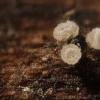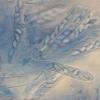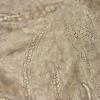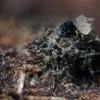
26-03-2013 12:54
hannie wijersHello,I hope anyone can help me with my "problem"�

21-04-2013 01:06
 Yannick Mourgues
Yannick Mourgues
Branche morte au sol avec Arachnopeziza aurelia, c

15-04-2013 13:56
Alain BRISSARDBonjour à tousLors d'une sortie hier sur le Causs

20-04-2013 20:20
hannie wijersThis frb was hairy, also on Rubus. I think the bro

18-04-2013 19:28
Hi to all On medium size (40-70 mm in diam.) fell

13-03-2013 10:36
Salut bonjour, J'ai trouvé cette espèce à Salam
On a pyrenomycete.
Dieter Slos,
20-04-2013 19:21
I found this fruitbody on a pyrenomycete. Any idea about it? Spores about 7.5 x 3 µm.
Best regards,
Dieter
Gilbert MOYNE,
20-04-2013 19:31
Re : On a pyrenomycete.
Sur Podospora ?
La forme des poils serait intéressante.
Gilbert
La forme des poils serait intéressante.
Gilbert
Dieter Slos,
20-04-2013 19:44
Re : On a pyrenomycete.
I don't know if it is podospora. Should check it. What are poils?
Björn Wergen,
20-04-2013 19:45

Re : On a pyrenomycete.
Hi,
looks like Unguiculella tityri, look here:
https://www.sites.google.com/site/funghiparadise/ascomycota-leotiomycetes/helotiales/hyaloscyphaceae/unguiculella-tityri-velen-huhtinen-spooner-2003-1?
regards,
björn
looks like Unguiculella tityri, look here:
https://www.sites.google.com/site/funghiparadise/ascomycota-leotiomycetes/helotiales/hyaloscyphaceae/unguiculella-tityri-velen-huhtinen-spooner-2003-1?
regards,
björn
Björn Wergen,
20-04-2013 19:49

Re : On a pyrenomycete.
poils = hairs
Gilbert MOYNE,
20-04-2013 20:09
Re : On a pyrenomycete.
C'est en ettet à Unguiculella tityri que je pensais.
Je l'ai toujours trouvée sur Podospora conica sur bouse de vache.
Gilbert
Je l'ai toujours trouvée sur Podospora conica sur bouse de vache.
Gilbert
Björn Wergen,
20-04-2013 20:25

Re : On a pyrenomycete.
Hi Gilbert,
I do not really understand what you have written there (sorry my french is bad). The main difference between the finding and U. tityri seems to be the ascus shape. It would be interesting which pyrenomycete it is.
regards,
björn
I do not really understand what you have written there (sorry my french is bad). The main difference between the finding and U. tityri seems to be the ascus shape. It would be interesting which pyrenomycete it is.
regards,
björn
Dieter Slos,
20-04-2013 20:35
Dieter Slos,
21-04-2013 13:30
Björn Wergen,
21-04-2013 13:58

Re : On a pyrenomycete.
I think it should be ok for U. tityri. So what is your region?
regards,
björn
regards,
björn



